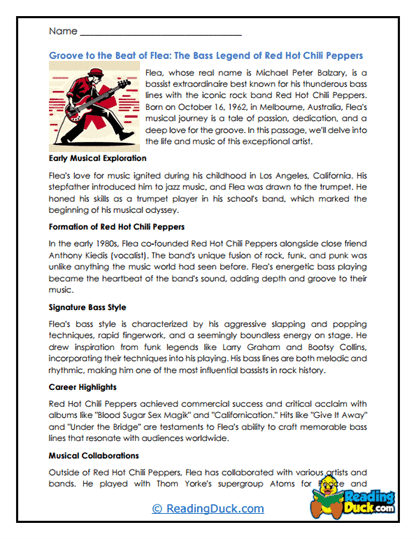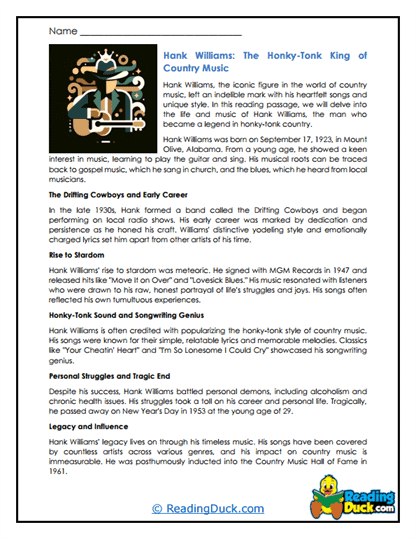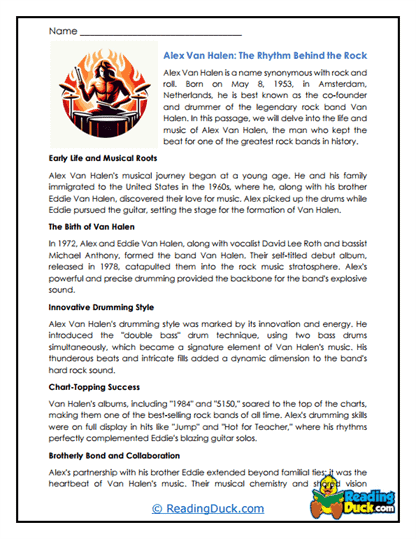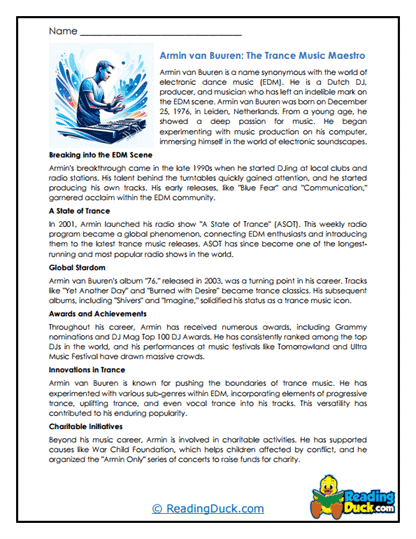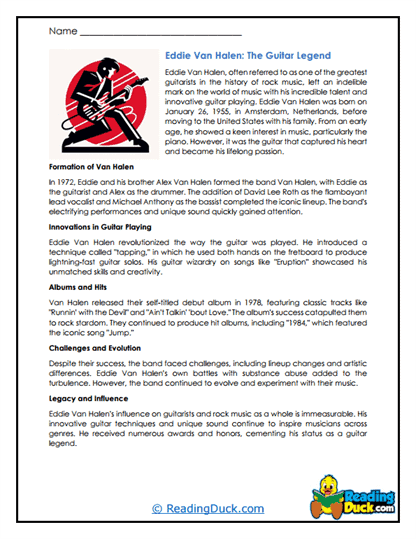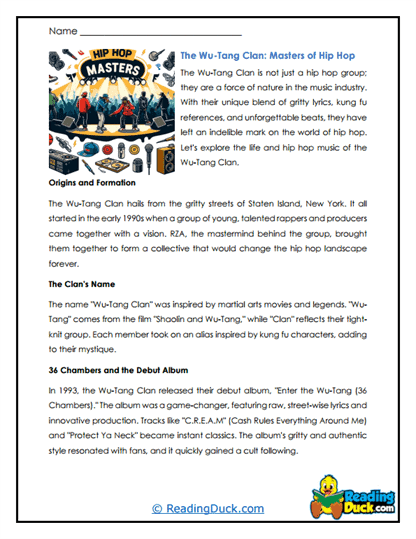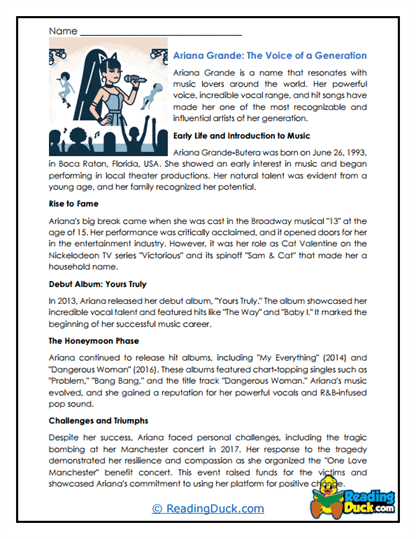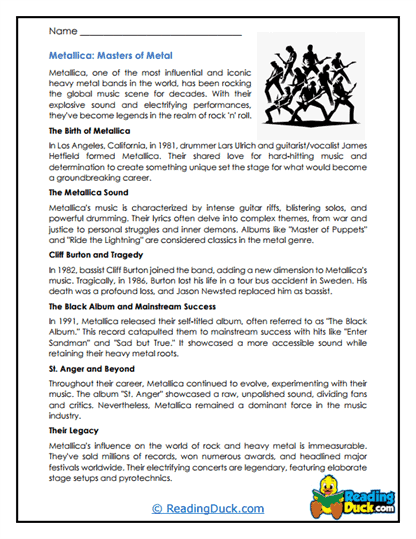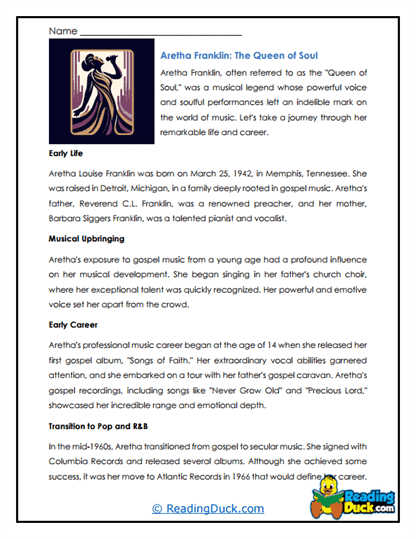Music Worksheets
About Our Music Worksheets
Welcome to our comprehensive collection of Music Worksheets! This collection is thoughtfully designed to engage students with the rich and diverse world of music through a variety of genres and artists.
The worksheets are divided into categories that focus on specific types of musicians and genres, including Bassists, Country Artists, Drummers, EDM Artists, Guitarists, Hip Hop Artists, Pop Artists, Rhythm and Blues, Rock Artists, and Singers. These categories provide students with a well-rounded exploration of music, allowing them to connect with different styles and appreciate the cultural significance of each.
Each category contains several worksheet sets, each designed to help students deepen their understanding of music and its influential figures. Each worksheet set includes:
- Multiple Choice Questions: These questions test students’ recall and comprehension of key details from the reading passage, encouraging them to think critically about the artist’s life, music style, and impact on the industry.
- Short Answer Questions: This format requires students to articulate their understanding in their own words, helping them to develop their analytical and writing skills while reflecting more deeply on the material.
- Open-Ended Questions: These questions invite students to share their personal interpretations, opinions, and preferences related to the content of the passage, fostering creativity, personal connection, and a deeper engagement with the material.
These varied question formats help assess students' understanding and enhance their connection to the music and artists they are studying. Each worksheet set also includes an answer key for ease of use.
All of the worksheets are available in PDF format, making them easy to view electronically, download, and print for use in any learning environment.
Overview of Topics in This Worksheet Collection
Our Music Reading Comprehension Worksheets cover a wide array of topics, each designed to give students a comprehensive look at different genres and the artists who define them. Here’s a breakdown of the categories included in this collection:
- Bassists:
- This category focuses on legendary bassists who have left a significant mark on the music industry. Students will explore the unique role that bassists play in creating the rhythm and foundation of a song. The worksheets cover influential figures across various genres, from funk to rock, and examine their technique, innovation, and contributions to music.
- Country Artists:
- Country music is known for its storytelling and emotional depth. This category highlights the careers and musical styles of iconic country artists, both classic and contemporary. Students will learn about the cultural roots of country music, the evolution of its sound, and the impact these artists have had on the genre.
- Drummers:
- Drummers are the heartbeat of a band, providing rhythm and energy. This category dives into the lives and techniques of some of the most famous drummers in music history. Students will gain an understanding of different drumming styles, from jazz to rock, and how these drummers have influenced the sound and direction of their respective bands.
- EDM Artists:
- Electronic Dance Music (EDM) has exploded in popularity over the past few decades. This category explores the pioneers and innovators of the EDM scene, looking at how they’ve used technology and creativity to push the boundaries of music. Students will learn about the rise of EDM, its cultural impact, and the unique processes these artists use to create their tracks.
- Guitarists:
- The guitar is a versatile instrument central to many genres. This category features some of the greatest guitarists of all time, spanning rock, blues, jazz, and more. Students will explore the distinct playing styles, techniques, and innovations that these guitarists have brought to their music, and how they’ve influenced future generations of musicians.
- Hip Hop Artists:
- Hip hop is not just a genre; it’s a cultural movement. This category covers influential hip hop artists who have shaped the genre with their lyrics, beats, and social commentary. Students will explore the origins of hip hop, its evolution, and how these artists use their platform to address issues such as identity, politics, and social justice.
- Pop Artists:
- Pop music is characterized by its broad appeal and catchy melodies. This category looks at the biggest names in pop, from past icons to current chart-toppers. Students will examine how these artists craft their music to appeal to wide audiences, the trends they set, and their influence on popular culture.
- Rhythm and Blues:
- R&B is a genre rich in emotion and soul. This category explores the contributions of R&B artists who have shaped the genre with their powerful voices and heartfelt lyrics. Students will learn about the origins of R&B, its evolution, and how these artists blend elements of jazz, blues, and gospel to create their sound.
- Rock Artists:
- Rock music has been a dominant force in popular culture for decades. This category features legendary rock artists who have defined the genre with their rebellious spirit, electrifying performances, and groundbreaking music. Students will explore the different subgenres of rock, from classic rock to punk, and the cultural impact these artists have had.
- Singers:
- Singers are the voice of music, delivering powerful performances that resonate with audiences. This category covers iconic singers from various genres, highlighting their vocal techniques, stage presence, and the emotional depth they bring to their music. Students will learn about the art of singing and how these artists connect with listeners on a personal level.
Each reading passage in these categories features a notable artist from that genre, offering insights into their style, life, and lasting legacy. The topics were chosen to provide a diverse and comprehensive exploration of music, allowing students to appreciate the artistry and influence of these musicians across different genres.
Developing a Deep Appreciation for Music
Understanding music and its history is an essential part of a well-rounded education. Here’s why incorporating music into the curriculum is so beneficial:
- Cultural Awareness:
- Music is a reflection of culture and history. By studying different genres and artists, students gain a deeper understanding of cultural diversity and the social and historical contexts that shape music.
- Critical Thinking:
- Analyzing music and its components—such as lyrics, rhythm, and instrumentation—enhances students’ critical thinking skills. They learn to interpret meaning, identify patterns, and make connections between music and broader societal issues.
- Creative Expression:
- Music encourages creativity, whether through listening, performance, or composition. Engaging with music helps students express themselves in unique ways, fostering emotional intelligence and personal growth.
- Improved Literacy Skills:
- Music worksheets that focus on reading comprehension can improve students’ literacy skills. They enhance vocabulary, reading fluency, and comprehension, particularly when analyzing song lyrics or biographical passages.
- Interdisciplinary Learning:
- Music intersects with various academic disciplines, including history, literature, and technology. This interdisciplinary approach enriches students’ overall educational experience, making learning more engaging and relevant.
How Teachers and Parents Can Integrate These Worksheets in a Learning Curriculum
Integrating these Music Reading Comprehension Worksheets into a learning curriculum can be highly beneficial for students across various grade levels. Here are some practical tips for teachers and parents:
- Incorporate into Music Classes:
- Use these worksheets as part of a broader music education curriculum, introducing students to different genres and artists. This approach can help students make connections between the music they listen to and the artists who create it.
- Cross-Curricular Connections:
- Connect the worksheets to history or social studies lessons by discussing the cultural and historical contexts of different music genres. For example, study the civil rights movement alongside the development of R&B or the impact of the 1960s counterculture on rock music.
- Assign as Homework or Independent Study:
- Assign the worksheets as homework to reinforce classroom learning or as part of an independent study project. This allows students to engage with the material at their own pace and develop their research and critical thinking skills.
- Group Discussions and Presentations:
- Encourage students to work in groups to analyze the reading passages and present their findings. Group discussions can deepen understanding and foster collaboration, while presentations help students develop public speaking skills.
- Use in Literature Classes:
- Incorporate the worksheets into literature lessons by analyzing song lyrics as poetry or exploring the narrative elements in the artists’ biographies. This approach can enhance students’ appreciation for both music and literature.
- Parental Involvement:
- Parents can use these worksheets at home to support their child’s learning. Discuss the reading passages together, explore the music of the featured artists, and encourage creative projects such as writing their own song lyrics or creating artwork inspired by the music.
- Interactive Projects:
- Assign interactive projects where students create their own music videos, design album covers, or write reviews of the artists and their work. These projects can help students connect with the material in a hands-on, creative way.
How These Worksheets Benefit Students
Studying music through these worksheets enhances a range of academic and personal skills. Students develop cultural awareness by exploring diverse genres, critical thinking by analyzing music and its context, and creative expression through their engagement with the material. Additionally, the worksheets improve literacy skills and provide opportunities for interdisciplinary learning, making them a valuable addition to any curriculum.
In conclusion, our Music Reading Comprehension Worksheets offer a comprehensive and engaging way to explore the world of music. By integrating these worksheets into the curriculum, teachers and parents can help students gain a deeper understanding of music’s cultural significance, while also developing essential academic and personal skills.
Through a combination of reading, analysis, and creative expression, these worksheets offer students the tools they need to connect with music on a meaningful level and appreciate its lasting impact on society.
